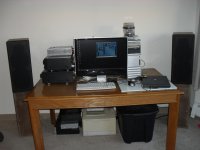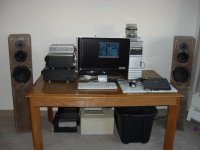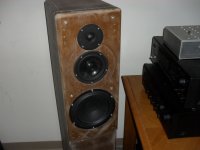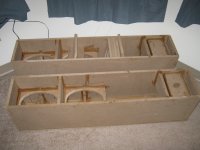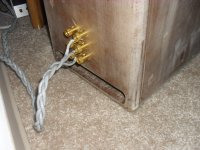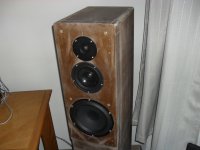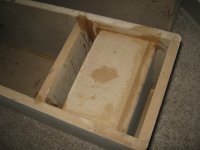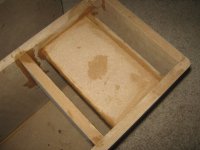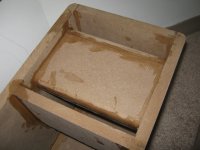While it may not apply to what you're trying to do (rounding over the port's ends), if a port with either or both ends flared is substituted for a port having non-flared ends, the port with one or both ends flared has to be lengthened in order to have the same tuning frequency as the port without either end flared. Just thought you ought to be aware.
Paul
Paul
Yes.
Yeah, I'm asking about the inside. The outside I will route with the 3/4" bit where I can.
I'm using ScanSpeak 21W/8555-01 per 1.70 cu. ft. enclosure with a 1 x 8.5 x 19.5" port with .3 lbs/cu.ft. polyfill. I don't plan to play them very loud, but it would be just dandy if they could without port noise.
Why is your smiley bleeding?
I have not had time to model your enclosure for port speed, but here is an interesting read I found:
http://www.troelsgravesen.dk/vent_tuning.htm
while I have not had time to fully read this article, I have read some of his others, they are all very good.
Ron
Smiley is bleeding because it is from the movie "Watchmen". 🙂
http://www.troelsgravesen.dk/vent_tuning.htm
while I have not had time to fully read this article, I have read some of his others, they are all very good.
Ron
Smiley is bleeding because it is from the movie "Watchmen". 🙂
I have not had time to model your enclosure for port speed, but here is an interesting read I found:
http://www.troelsgravesen.dk/vent_tuning.htm
while I have not had time to fully read this article, I have read some of his others, they are all very good.
I forgot to read that article a few weeks ago

I wound up going ported due to size and reading peoples opinions in this thread.
If I had the room I would build a TL or a horn maybe 🙂
If I had the room I would build a TL or a horn maybe 🙂
If you don't like the sound and temperament of a ported enclosure, you can always use the audiophile approved method of stuffing it with a color matching sock!
Pictures???
Ron
Pictures???
Ron
Guess I'll try this question once again since the subject has come up.
Anyone heard of tuning a port with a lit candle? (or a stick of incense or any other handy form of primitive air manometer)
I was reminded of this recently when a poster mentioned how far measuring has come with modern computer modeling. "Gone are the days" he said "when one would simply use the Fs of the driver and adjust the port for minimal cone movement at that frequency" (or some such paraphrase. i can't remember where i saw this statement)
I had asked here a couple of years ago if anyone had heard of doing this candle trick and it seemed a mystery. There was a fellow downtown that ran an audio store when I was in high school in the early seventies and I'm almost certain that I remember him tuning a speaker port in this fashion. Minimal cone movement making the candle stop flickering while he fed the speaker a test tone and tinkered with the port lengths.
What I'm wondering now is whether or not this method would still be any use as a final test to tune the port of a bass reflex project, after all is said and done, measured and built, having utilized the latest computer modeling? Or is any speaker's Fs a moving target?
Anyone heard of tuning a port with a lit candle? (or a stick of incense or any other handy form of primitive air manometer)
I was reminded of this recently when a poster mentioned how far measuring has come with modern computer modeling. "Gone are the days" he said "when one would simply use the Fs of the driver and adjust the port for minimal cone movement at that frequency" (or some such paraphrase. i can't remember where i saw this statement)
I had asked here a couple of years ago if anyone had heard of doing this candle trick and it seemed a mystery. There was a fellow downtown that ran an audio store when I was in high school in the early seventies and I'm almost certain that I remember him tuning a speaker port in this fashion. Minimal cone movement making the candle stop flickering while he fed the speaker a test tone and tinkered with the port lengths.
What I'm wondering now is whether or not this method would still be any use as a final test to tune the port of a bass reflex project, after all is said and done, measured and built, having utilized the latest computer modeling? Or is any speaker's Fs a moving target?
Last edited:
Minimal cone movement making the candle stop flickering while he fed the speaker a test tone and tinkered with the port lengths.
I would imagine you would see more of a flicker when you put the candle near the port.
If you don't like the sound and temperament of a ported enclosure, you can always use the audiophile approved method of stuffing it with a color matching sock!
Pictures???
Ron
I must say that this project really makes me realize I'm not much of an audiophile. I think the ported is tuned low and the bass enclosure has a fair amount of polyfill. I will post pics now although I am somewhat embarrassed of my routing work. I didn't have the best router or bits or circle cutting jig, but I could have done better if I didn't have to drive 2 hours to my sister in-law's house to router my speaker. The grills fabric might have to be redone; you can see the staples through it because I had to make childproof grills.
Attachments

 Here is the thread about childproof grills: http://www.diyaudio.com/forums/multi-way/152358-child-proof-grills.html
Here is the thread about childproof grills: http://www.diyaudio.com/forums/multi-way/152358-child-proof-grills.htmlAttachments
Last edited:
Will be a lot of turbulense in there Jimmy.
Ports +cabinets should be designed with that in mind. Asymetric cabinets and "trumpet"-shaped ports both in- and outside 😉
Ports +cabinets should be designed with that in mind. Asymetric cabinets and "trumpet"-shaped ports both in- and outside 😉
The thing that has bothered me most about TL systems is the time delay of the line output which, when I began noticing it, started to annoy me. Also, without sufficient care to damp higher frequencies from the delay line output, it can easily interfere with imaging.
I don't 'like' BR bass either, but I ultimately decided to use it in an overdamped configuration where the port tuning was no higher than 32hz with the response 6db or so down at that frequency. In this case, the group delay at 40 hz or above is significantly less than a conventional BR tuning at that frequency and there is the advantage of an additional third to half octave extension. I can augment the response down to 40 hz in this case by using special xover techniques that, incidentally, tend to flatten the upper BR resonant peak. So, overall, I feel this approaches closed box response and transient characteristics down to F3 but with the advantages of higher efficiency/lower distortion or smaller system size.
I don't 'like' BR bass either, but I ultimately decided to use it in an overdamped configuration where the port tuning was no higher than 32hz with the response 6db or so down at that frequency. In this case, the group delay at 40 hz or above is significantly less than a conventional BR tuning at that frequency and there is the advantage of an additional third to half octave extension. I can augment the response down to 40 hz in this case by using special xover techniques that, incidentally, tend to flatten the upper BR resonant peak. So, overall, I feel this approaches closed box response and transient characteristics down to F3 but with the advantages of higher efficiency/lower distortion or smaller system size.
Last edited:
Will be a lot of turbulense in there Jimmy.
Ports +cabinets should be designed with that in mind. Asymetric cabinets and "trumpet"-shaped ports both in- and outside 😉
Yes, I know 😱 At the time I was building them I only had a 1/2" round-over router bit I used inside the ports. But on the outside of the speaker, due to poor planning, I decided to only use a small portion of the 1/2" router bit to round the inside of the port over because I didn't want to impact the look of the speaker. But I could round it over a bit more without it effecting the side profile appearance of the speaker. I must have just forgotten about it somewhere along the way. The outside of the port doesn't look like it's round over, but it is a little bit.
Later on I obtained a 3/4 round-over bit, but the port panels were already glued in place. Also I should put in modelings were the port makes a turn, on the outside of the turn, but I haven't looked into finding those modeling, if they exist, yet.
I don't 'like' BR bass either, but I ultimately decided to use it in an overdamped configuration where the port tuning was no higher than 32hz with the response 6db or so down at that frequency.
I tuned the bass enclosures to 25 Hz where it should be down 3 db (combined with driver), in an open space, to adjust for room lift. If I didn't live in an apartment I might have not done this though. These speakers are actually a bit of a waste at decibel level I feel comfortable playing them at, particularly the bass. I have not used any EQ's on this system so far, but now that you mention it, I think I will try to contour the bass so it mimics the response of a sealed enclosure, in the near future. Not sure how well that will go with kx project drivers.
I'm listening to some ambient electronic music now at: http://yp.shoutcast.com/sbin/tunein-station.pls?id=697643 at a very low dB level and I worry that it might be bothering my neighbors.
Last edited:
I don't 'like' BR bass either, but I ultimately decided to use it in an overdamped configuration where the port tuning was no higher than 32hz with the response 6db or so down at that frequency. In this case, the group delay at 40 hz or above is significantly less than a conventional BR tuning at that frequency and there is the advantage of an additional third to half octave extension. I can augment the response down to 40 hz in this case by using special xover techniques that, incidentally, tend to flatten the upper BR resonant peak. So, overall, I feel this approaches closed box response and transient characteristics down to F3 but with the advantages of higher efficiency/lower distortion or smaller system size.
I couldn't agree with you more.
I'm thinking of adding a pair of sealed Peerless 830500 subwoofers to my system and it seems like a 12" sealed and a 8" ported driver have roughly the same output at a given displacement at about 20-30 Hz. At tuning the ported one has less displacement. I'm referring to the output around 20-30 Hz, but the displacement at higher frequencies also.
Maybe I should make the Peerless subs ported. I'm not sure.
Ported vs Sealed Listening Test
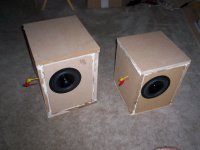
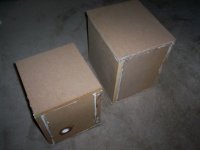
Hello! I'm building a WMTMW center channel speaker and need to have the bass as transparent as possible to match the mids and tweeter. Since I have two Dayton RS150-4 6" drivers, I have whacked together a sealed and a ported test enclosure for each.
I have just completed a single-blind listening test performed by the most disinterested person I could find, my wife. She truly does not care which sounds better. I had her label the speakers A & B at random, and entered the room with eyes closed, etc. The music was Janecek on Reference Recordings, and a jazz drummer headlining a group. Both are HDCD quasi-20 bit, mixed to mono.
The frequency range was limited to 120hz to about 3Khz by a third order active crossover before the power amp, so the F3 difference of 58 hz for ported versus 90-something for sealed was ignored for this test.
During the classical music, I could hear more distinctly the plucked strings, could differentiate harp from the other strings, on the sealed box. For the jazz, again the sealed box excelled at keeping the big drums separate from the string bass. It was not obvious, but it was apparent.
My wife preferred the sound of what turned out to be the sealed enclosure as well. I would have liked to do some more tests with Holm Impulse and my test mike, maybe some square wave traces, but she kicked me and my ugly boxes out of the living room.


Hello! I'm building a WMTMW center channel speaker and need to have the bass as transparent as possible to match the mids and tweeter. Since I have two Dayton RS150-4 6" drivers, I have whacked together a sealed and a ported test enclosure for each.
I have just completed a single-blind listening test performed by the most disinterested person I could find, my wife. She truly does not care which sounds better. I had her label the speakers A & B at random, and entered the room with eyes closed, etc. The music was Janecek on Reference Recordings, and a jazz drummer headlining a group. Both are HDCD quasi-20 bit, mixed to mono.
The frequency range was limited to 120hz to about 3Khz by a third order active crossover before the power amp, so the F3 difference of 58 hz for ported versus 90-something for sealed was ignored for this test.
During the classical music, I could hear more distinctly the plucked strings, could differentiate harp from the other strings, on the sealed box. For the jazz, again the sealed box excelled at keeping the big drums separate from the string bass. It was not obvious, but it was apparent.
My wife preferred the sound of what turned out to be the sealed enclosure as well. I would have liked to do some more tests with Holm Impulse and my test mike, maybe some square wave traces, but she kicked me and my ugly boxes out of the living room.
Paul, are you sure you're not testing differences in the frequency responses of the boxes, rather than a difference in ported / bass reflex?
The thing that has bothered me most about TL systems is the time delay of the line output which, when I began noticing it, started to annoy me. Also, without sufficient care to damp higher frequencies from the delay line output, it can easily interfere with imaging.
I don't 'like' BR bass either, but I ultimately decided to use it in an overdamped configuration where the port tuning was no higher than 32hz with the response 6db or so down at that frequency. In this case, the group delay at 40 hz or above is significantly less than a conventional BR tuning at that frequency and there is the advantage of an additional third to half octave extension. I can augment the response down to 40 hz in this case by using special xover techniques that, incidentally, tend to flatten the upper BR resonant peak. So, overall, I feel this approaches closed box response and transient characteristics down to F3 but with the advantages of higher efficiency/lower distortion or smaller system size.
Everything else being equal, the output of a TL, FLh, BLH, or TH will have half the delay of a BR because it's only 90 degrees out of phase versus 180 in a BR
Reply to Keriwena's question, "Paul, are you sure you're not testing differences in the frequency responses of the boxes, rather than a difference in ported / bass reflex?"
Yes, the frequency response for each was the same, because of the bandpass filter before the power amp.
Yes, the frequency response for each was the same, because of the bandpass filter before the power amp.
I'm a little troubled by that test and your conclusions because you have band limited the units so that the bottom Octaves, where they are likely to show differences, are filtered out.
A third order at 120 filter will have the vented box 58 Hz cuttoff about 18 dB down and the sealed box 90 Hz cuttoff about half of that. That doesn't guarantee that their rolloff regions are totaly gone due to the filter but they are getting there. Other possibilities to consider are that the different room positions gave different frequency response in the pass band (above 120).
If we really wanted to compare vented to sealed I think we would want two systems purpose designed to give the same cutoff (probably same -10dB point) and no external rolloff filtering. In-room measurements would need to confirm that the LF room response was the same. Placing the units face to face would probably get them close enough to share the same effective position. I know that placing them side by side would not.
Even then you must consider that choice of what common cuttoff is a factor. Set it low enough and differences between the design types (group delay at cuttoff) become irrelevant as your signal doesn't get low enough.
You might have better luck listening to 2nd and 4th order high pass filters (representing the box types) with a system of very extended and very flat (EQ and room damping) response.
Be wary of generalizations.
David S.
A third order at 120 filter will have the vented box 58 Hz cuttoff about 18 dB down and the sealed box 90 Hz cuttoff about half of that. That doesn't guarantee that their rolloff regions are totaly gone due to the filter but they are getting there. Other possibilities to consider are that the different room positions gave different frequency response in the pass band (above 120).
If we really wanted to compare vented to sealed I think we would want two systems purpose designed to give the same cutoff (probably same -10dB point) and no external rolloff filtering. In-room measurements would need to confirm that the LF room response was the same. Placing the units face to face would probably get them close enough to share the same effective position. I know that placing them side by side would not.
Even then you must consider that choice of what common cuttoff is a factor. Set it low enough and differences between the design types (group delay at cuttoff) become irrelevant as your signal doesn't get low enough.
You might have better luck listening to 2nd and 4th order high pass filters (representing the box types) with a system of very extended and very flat (EQ and room damping) response.
Be wary of generalizations.
David S.
What Dave said.Yes, the frequency response for each was the same, because of the bandpass filter before the power amp.
Plus, you seem to be assuming the frequency response of both drivers is the same. And assuming your closed box has a Q of .707, and that the BR alignment has no ripple, as well.
- Home
- Loudspeakers
- Multi-Way
- Ported vs TL vs sealed
